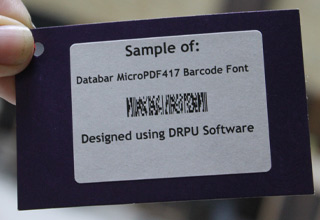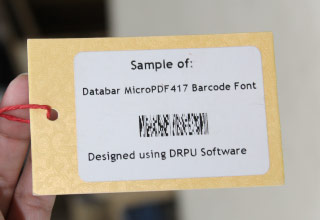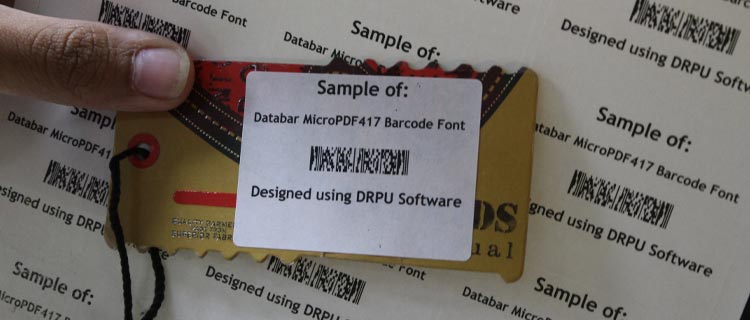Posted By: 👤 Technogeek
Last Updated On:
📝 Topics
Overview

The MicroPDF417 barcode is a type of PDF417 barcode, which is a two-dimensional barcode that is capable of encoding large amounts of data. However, unlike the standard PDF417 barcode, which is larger in size and can encode up to 1850 bytes of data, the MicroPDF417 barcode is smaller in size and can encode up to 1500 bytes of data.
The Databar MicroPDF417 barcode was developed by Symbol Technologies, now a part of Zebra Technologies. It is designed to provide a high level of data density, while also being able to handle a wide range of information types, including text, numeric data, and binary data.
One of the key advantages of the Databar MicroPDF417 barcode is its ability to store a large amount of data in a relatively small amount of space. This makes it ideal for use in applications where space is limited, such as on small packages or in medical devices.
Another advantage of the Databar MicroPDF417 barcode is its ability to encode a wide range of data types. This makes it ideal for use in applications where multiple data types need to be encoded, such as medical records or shipping manifests.
The Databar MicroPDF417 barcode is also designed to be highly reliable, even in harsh or demanding environments. It is capable of withstanding exposure to extreme temperatures, humidity, and physical stress, making it ideal for use in outdoor or industrial settings.
To create a Databar MicroPDF417 barcode, a special software application is required. This software application can be used to create a barcode image, which can then be printed onto a label or other packaging material. Once the barcode has been printed, it can be scanned by a barcode scanner or other imaging device, which will decode the information encoded within the barcode.
In order to decode a Databar MicroPDF417 barcode, a special imaging device is required. This imaging device uses a series of sensors to capture an image of the barcode, which is then analyzed by specialized software to decode the information encoded within the barcode.
Overall, the Databar MicroPDF417 barcode is a powerful and versatile tool for encoding and storing data. Its high data density, ability to handle multiple data types, and rugged design make it ideal for use in a wide range of industries, particularly those that require reliable and efficient data storage and retrieval.
Download and Install Barcode Software for Windows
Difference of Databar MicroPDF417 Barcode from Other Types of Barcodes
Databar MicroPDF417 is a two-dimensional stacked barcode symbology that is used to encode a large amount of data in a small space. It differs from other types of barcodes in several ways, including its compact size, high density, and ability to store multiple types of data.
One of the primary differences between Databar MicroPDF417 and other types of barcodes is its size. Databar MicroPDF417 is a very compact barcode, typically measuring only a few square millimeters in size. This allows it to be used in applications where space is at a premium, such as on small products or in cramped industrial environments.
Another key difference is the high density of data that can be stored in a Databar MicroPDF417 barcode. This is achieved by stacking multiple rows of barcodes on top of each other, creating a three-dimensional structure that can hold a large amount of information. As a result, Databar MicroPDF417 is often used in applications where a lot of data needs to be encoded in a small space, such as on medical equipment or automotive components.
In addition to its compact size and high density, Databar MicroPDF417 also has the ability to store multiple types of data. This includes alphanumeric characters, symbols, and even images. This versatility makes Databar MicroPDF417 an ideal choice for applications where a diverse range of data needs to be encoded, such as on pharmaceutical labels or on shipping containers.
Overall, the compact size, high density, and ability to store multiple types of data are the primary ways that Databar MicroPDF417 differs from other types of barcodes. These features make it an ideal choice for a wide range of applications where space is limited and a lot of information needs to be encoded.
Purpose of using a Databar MicroPDF417 Barcode
The purpose of using a Databar MicroPDF417 barcode is to encode a large amount of data in a small space. This makes it an ideal choice for applications where space is at a premium, and a lot of information needs to be encoded, such as on medical equipment, pharmaceutical labels, and shipping containers.
One of the primary benefits of using a Databar MicroPDF417 barcode is its high data density. This is achieved by stacking multiple rows of barcodes on top of each other, creating a three-dimensional structure that can hold a large amount of information. This makes it an ideal choice for applications where a lot of data needs to be encoded in a small space, such as on medical equipment where there may be limited space for labels.
Another key benefit of using a Databar MicroPDF417 barcode is its versatility. It can store alphanumeric characters, symbols, and even images, making it an ideal choice for applications where a diverse range of data needs to be encoded. For example, on pharmaceutical labels, a Databar MicroPDF417 barcode can be used to encode information such as the product name, dosage, expiration date, lot number, and manufacturer information, as well as any warnings or precautions that need to be conveyed.

Databar MicroPDF417 is also ideal for use in industrial applications where labels need to be resistant to harsh environments such as heat, moisture, or chemicals. This is because the barcode is designed to be highly resistant to damage, and can be read even when the label is partially obscured or damaged.
Another advantage of using a Databar MicroPDF417 barcode is that it can be read quickly and accurately using handheld scanners or mobile devices. This makes it an ideal choice for applications such as inventory management, where large numbers of items need to be quickly scanned and identified.
Overall, the purpose of using a Databar MicroPDF417 barcode is to encode a large amount of information in a small space, while also providing versatility, durability, and ease of use. It is a highly effective and efficient method for encoding and decoding data, and is used in a wide range of applications across industries such as healthcare, pharmaceuticals, logistics, and manufacturing.
Advantages of using a Databar MicroPDF417 Barcode
Databar MicroPDF417 is a type of two-dimensional (2D) barcode that is capable of storing large amounts of data in a small space. There are several advantages of using Databar MicroPDF417 barcodes, which have made them a popular choice in various industries. In this answer, we will discuss the advantages of using Databar MicroPDF417 barcodes in detail.
- High Data Capacity: One of the main advantages of using Databar MicroPDF417 barcodes is their high data capacity. These barcodes can store up to 1,160 bytes of data, which is significantly more than other 2D barcodes such as QR codes or Data Matrix codes. This high data capacity makes Databar MicroPDF417 barcodes ideal for applications that require the storage of large amounts of data, such as inventory management, shipping, and logistics.
- Small Size: Despite their high data capacity, Databar MicroPDF417 barcodes are relatively small in size. They can be printed at a high resolution, which allows them to be read by a barcode scanner even when they are printed on small items or labels. This small size makes them ideal for use in applications where space is limited, such as on small products or packages.
- Error Correction: Databar MicroPDF417 barcodes incorporate advanced error correction techniques, which help to ensure that the barcode can be read even if it is damaged or partially obscured. This is particularly useful in applications where the barcode may be subject to wear and tear or where it may be exposed to harsh environments.
- Scalability: Databar MicroPDF417 barcodes can be easily scaled up or down in size, depending on the application requirements. This makes them suitable for use in a wide range of applications, from small items such as jewelry or electronic components to large items such as shipping containers.
- Security: Databar MicroPDF417 barcodes can be encrypted to provide an additional layer of security. This is particularly useful in applications where the barcode contains sensitive information, such as in the healthcare or financial industries.
- Flexibility: Databar MicroPDF417 barcodes are highly flexible and can be used in a wide range of applications. They can be printed on a variety of surfaces, including paper, plastic, and metal, and can be read by a wide range of barcode scanners. This flexibility makes them a popular choice in a variety of industries, including manufacturing, healthcare, and logistics.
- Multiple Data Formats: Databar MicroPDF417 barcodes can store multiple data formats, including text, numbers, and binary data. This makes them suitable for use in a wide range of applications, from inventory management to patient identification in healthcare.
In summary, Databar MicroPDF417 barcodes offer a range of advantages, including high data capacity, small size, error correction, scalability, security, flexibility, and the ability to store multiple data formats. These advantages have made them a popular choice in various industries, where they are used in a wide range of applications.
Limitations of using Databar MicroPDF417 Barcodes
Databar MicroPDF417 barcodes have several advantages, such as high-density coding capability, error correction, and flexibility in terms of data format. However, there are also some limitations to using these barcodes.

One limitation is that not all barcode scanners can read MicroPDF417 barcodes, as they require specialized scanners that are capable of decoding 2D barcodes. This can be a problem in situations where there are different types of barcodes being used, or when barcode scanning is outsourced to a third-party service provider.
Another limitation is the limited data capacity of MicroPDF417 barcodes. While they have a high-density coding capability, they are not able to store as much data as other 2D barcodes, such as QR codes or Data Matrix codes. This can be a problem in situations where large amounts of data need to be encoded in the barcode.
MicroPDF417 barcodes are also sensitive to printing quality and readability can be affected by poor printing quality, such as low contrast or smudging. This can result in errors during scanning and decoding of the barcode, which can lead to delays and other issues.
Additionally, MicroPDF417 barcodes are not suitable for applications that require high-speed scanning, such as in manufacturing or logistics operations. The relatively complex structure of MicroPDF417 barcodes can make them slower to scan compared to simpler barcodes like Code 128.
Finally, the use of MicroPDF417 barcodes may require additional training and resources for companies that are not familiar with this barcode type. This can include investments in specialized software and hardware for barcode printing and scanning, as well as training employees on the proper use and handling of MicroPDF417 barcodes.
In summary, while Databar MicroPDF417 barcodes offer several advantages, they also have limitations in terms of compatibility with barcode scanners, data capacity, sensitivity to printing quality, suitability for high-speed scanning applications, and the need for additional resources and training.